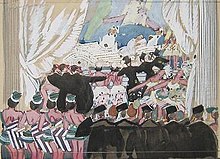Scenic design




Scenic design (also known as scenography, stage design, set design or production design) is the creation of theatrical, as well as film or television scenery. Scenic designers have traditionally come from a variety of artistic backgrounds, but nowadays, generally speaking, they are trained professionals, often with M.F.A. degrees in theatre arts.
The stage
The "stage picture" is the "look" or physical appearance of the stage for a play, whether in rehearsal or performance. It reflects the way that the stage is composed artistically in regard to props, actors, shapes and colours. The stage picture should express good principles of design and use of space. It should be visually appealing for the audience or should express the show's concept.
Responsibility

The scenic designer is responsible for collaborating with the theatre director and other members of the production design team to create an environment for the production and then communicating the details of this environment to the technical director, production manager, charge scenic artist and propmaster. Scenic designers are responsible for creating scale models of the scenery, renderings, paint elevations and scale construction drawings as part of their communication with other production staff.
Training
In Europe and Australia[1] scenic designers take a more holistic approach to theatrical design and will often be responsible not only for scenic design but costume, lighting and sound and are referred to as theatre designers or scenographers or production designers.
Like their American cousins, European theatre designers and scenographers are generally trained with Bachelor of Arts degrees in theatre design, scenography or performance design.
Notable scenic designers, past and present, include: Adolphe Appia, Aleksandra Ekster, Alexandre Benois, Alison Chitty, Antony McDonald, Barry Kay, Boris Aronson, Cyro Del Nero, Daniil Lider, David Borovsky, David Gallo, Edward Gordon Craig, Es Devlin, Ezio Frigerio, Franco Colavecchia, Franco Zeffirelli, George Tsypin, Howard Bay, Inigo Jones, Jean-Pierre Ponnelle, Jo Mielziner, Josef Svoboda, Ken Adam, Léon Bakst, Luciano Damiani, Maria Björnson, Ming Cho Lee, Motley, Natalia Goncharova, Nathan Altman, Nicholas Georgiadis, Paul Brown, Oliver Smith, Ralph Koltai, Neil Patel, Robert Brill, Robert Wilson, Russell Patterson, Brian Sidney Bembridge, Santo Loquasto, Sean Kenny, Todd Rosenthal, Robin Wagner, Tony Walton, and Vadym Meller.
References
- ^ "Training as a Theatre Designer". Central School of Speech and Drama, University of London article.
See also
Further reading
- Making the Scene: A History of Stage Design and Technology in Europe and the United States by Oscar G. Brockett, Margaret Mitchell, and Linda Hardberger (Tobin Theatre Arts Fund, distributed by University of Texas Press; 2010) 365 pages; traces the history of scene design since the ancient Greeks.
External links
- Prague Quadrennial of Performance Design and Space - the largest scenography event in the world - presenting contemporary work in a variety of performance design disciplines and genres - costume, stage, light, sound design, and theatre architecture for dance, opera, drama, site specific, multi-media performances, and performance art, etc., Prague, CZ
- Master's Degree in Scenography and Contemporary Cities in Barcelona
- Society of British Theatre Designers Theatre Design
- What is Scenography Article illustrating the differences between US and European theatre design practices
- Stagelink Production and Set Designer Directory
- Josef Svoboda Article on www.scenography.co.uk
- Theatre Set and Costume Design Archive at the University of Bristol Theatre Collection, University of Bristol
